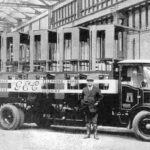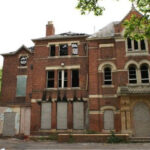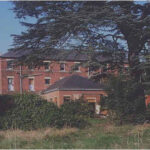Copsewood Grange
Homepage » Copsewood Grange
Copsewood Grange
Copsewood Grange was erected in 1872 by James Hart, a ribbon manufacturer. The date 1870 is on the Lodge at the entrance to the Grange with what seem to be Hart’s initials carved in the stone. The estate buildings are said to
have cost £5000. Hart’s large factory, the Victoria Mills, was in Lancastrian Yard in the Burges, the site is now part of the West Orchards shopping complex. With the decline of the ribbon trade, both the Grange and the factory
became known as Hart’s Folly.
The Grange was sold in 1879 to Mr. Richard Moon M.D. of the London
and North Western Railway, and he was living there when he was elevated to a Baronet. The estate now covered more than 200 acres and included the site of the old Biggin Hall. It is said that Richard Moon bought this house
because it overlooked the London to Birmingham railway line, so he could keep an eye on the trains to see if they were running on time. After Richard Moon, a Mrs Mellodew and her two daughters lived at the Grange – (Mellowdew
Road, with incorrect spelling, is named after her).
The Grange was sold again in the 1920s when the Peel Conner Telephone Company, which later became the GEC (General Electrical Company), moved from Salford to Coventry to design and manufacture telephone exchange equipment. A
huge tract of land was purchased on which was built the factory and housing for employees. GEC used Copsewood Grand as a hostel and social centre for its first employees when the manufacture of telephone equipment was
transferred from Salford. These residents planned and initiated the golf course construction and this was recognised as one of the best staff clubs in the country. It was also the clubhouse for the Marconi Golf Club.
In 1968 deep excavations were dug across the golf course for a new sewage system. This was the setting for the famous scene in the film “The Italian Job” starring Michael Caine, with mini cars racing through a giant pipe. In the
1980s Allard Way was also built through the middle of the golf course and as the fortunes of GEC fluctuated during the 1990s, the club’s name also changed from GEC through GPT to Marconi.
When Plessey/ Marconi closed the factory, it was demolished and the site was to be redeveloped. At that time the City Council had a policy that with land that had once been industrial land, one third should stay as industrial
use. Unfortunately the one third that was left for industrial use was the area that Copsewood Grange and Copsewood Lodge was in. The other two third of the site was to be developed for housing. It was clear that no one would
take on the Grange as industrial development. The Grange and The Lodge both fell into disrepair and were attacked by vandals and set on fire.
In response to this problem the Coventry Society set up a campaign group to save the historic buildings. Apart from the heritage aspect of the mansion itself, we also argued that its fine sylvan surroundings and landscaped
parkland of high quality, was unsuitable for warehouse/industrial units. Endless efforts to secure commercial interest were repeatedly unsuccessful and the Society maintained its position insisting it should be re‐allocated for
residential purposes. ‘Save Britain’s Heritage’, joined the campaign and added the property to its “buildings at risk” register. An emergency protection notice was served by the council for both Copsewood Grange and Copsewood
Lodge. While we appreciated the need to reserve land for industry and jobs it was quite clear to us that the prospect of years of dereliction and continuing vandalism would not only have a negative effect on the Stoke area but
also be a significant loss to the whole of the City.
At last the City Council changed its mind and in 2012
approval was given for the construction of 329 homes and a
retail unit. Alterations to Copsewood Lodge enabled its rehabilitation as a three‐bedroom dwelling. The plans required the Grange itself to be adapted to create 17 apartments with an internal access road and most importantly a
comprehensive management scheme for the trees within the site. A Section 106 Agreement with the developer enabled significant facilities to be provided for the New Century Park community.
Work on the development of the housing is now complete, together with the Grange and the Lodge and the Society consider the buildings to no longer be at risk.
In addition to the intrinsic value of these impressive historic buildings, their refurbishment has delivered new residential accommodation, contributing to the demand for new homes in the city. We see this as “A win-win” for
developers Morris Homes, the Council and the local community.
You can read a news story about the re-opening of Copsewood Grangs here.






